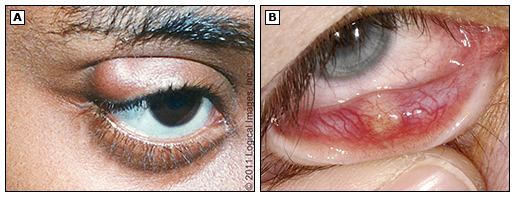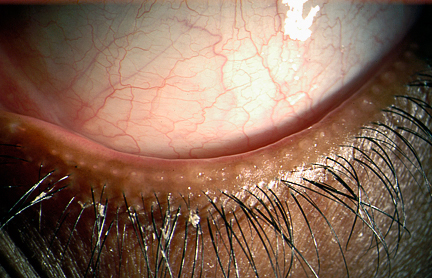Eyelid Disorders
Overview
Stye (Hordeolum)
What is a stye? — A stye is a red and painful lump on the eyelid. It happens when a small gland on the edge of the eyelid gets infected or inflamed. Styes can occur on the upper or lower eyelids. Most styes get better on their own after a few days to a week. Another word for stye is “hordeolum.”
People sometimes get a stye confused with a different eye problem called a “chalazion.” A chalazion also causes a lump on the eyelid. But a stye is caused by an infection and is painful. A chalazion is not tender or painful, but it often lasts longer than a stye does.
What are the symptoms of a stye? — People who have a stye have a red and painful lump on the edge of their eyelid (picture 1). A stye usually develops over a few days. It can look like a pimple. Styes can cause other symptoms, too, such as tearing and eyelid pain and swelling.
Is there a test for a stye? — No. But your doctor or nurse should be able to tell if you have a stye by talking with you and doing an exam.
Is there anything I can do on my own to feel better? — Yes. To ease your symptoms and help your stye get better, you can put a warm, wet compress on the stye. Wet a clean washcloth with warm water and put it over your stye. When the washcloth cools, reheat it with warm water and put it back over the stye. Repeat these steps for about 15 minutes, and try to do this 4 times a day.
You should not squeeze or pop your stye. This can make it worse. Also, you should not wear eye makeup or contact lenses until your stye is all better.
Should I see a doctor or nurse? — See your doctor or nurse if:
●Your stye doesn’t go away after using warm compresses for 1 to 2 weeks
●Your stye gets very big, bleeds, or affects your vision
●Your whole eye is red, or your whole eyelid is red and swollen
●The redness or swelling spreads to your cheek or other parts of your face
What treatments might my doctor use? — If your stye doesn’t get better or if it leads to other problems, your doctor might:
●Prescribe a cream or ointment that goes in the eye and on the eyelid
●Prescribe antibiotic medicines
●Do a procedure to drain the stye
Can styes be prevented? — Yes. To lower your chances of getting a stye, you can:
●Wash your hands often – It’s especially important to wash your hands before you touch your eyes. Also, if you wear contact lenses, keep them clean and wash your hands before you put them in.
●Be careful with your eye makeup – Wearing eye makeup can sometimes cause a stye. Remove your eye makeup each night, and throw away old makeup. Do not share eye makeup with other people.
picture 1: Stye

This person has a stye in the middle of the lower eyelid.
Chalazion
What is a chalazion? — A chalazion is a painless lump in the eyelid. It is caused by a blockage in a gland that makes tears.
A chalazion is different from a “stye,” which also causes a lump on the eyelid. But a stye is caused by an infection and is painful. A chalazion is not tender or painful, but it often lasts longer than a stye does.
What are the symptoms of a chalazion? — A chalazion often begins with redness and swelling. Then, a firm, painless lump forms, usually in the upper eyelid. The lump can be as large as a pea. If a chalazion forms in the lower eyelid, it looks like a yellow-white bump.
Is there a test for a chalazion? — No. But your doctor or nurse should be able to tell if you have a chalazion by doing an exam and talking with you.
Is there anything I can do on my own to treat this? — Yes. You can put warm, wet pressure on the chalazion. Wet a clean washcloth with warm water and put it over your chalazion. When the washcloth cools, reheat it with warm water and put it back over the chalazion. Repeat these steps for 15 minutes, 4 times a day.
You should not squeeze or pop your chalazion.
How is chalazion treated? — Most of the time, a chalazion goes away with the treatment described above within a few weeks. It might even go away on its own. But if you have a large chalazion that does not go away or keeps coming back, your doctor might refer you to an eye doctor. He or she can do a procedure in the office to remove the chalazion or inject a medicine into the chalazion to reduce the swelling.
picture 2: Chalazion in the eyelid

A chalazion is a firm, painless bump that can form in the upper eyelid (A) or the lower eyelid (B).
Blepharitis
What is blepharitis? — Blepharitis is inflammation of the eyelids that causes redness and swelling of the lids. The symptoms might get better and then come back. But blepharitis rarely causes problems with your vision.
Blepharitis is more common in people who have certain skin conditions, including:
●Rosacea – This causes redness and raised, red bumps on the cheeks, nose, chin, forehead, or eyelids.
●Seborrhea – This causes redness, scaly patches, and itching, mostly on the scalp. Dandruff is a mild form of seborrhea.
What are the symptoms of blepharitis? — The symptoms include:
●Eyelids that are red, swollen, and itchy
●A gritty or burning feeling in the eyes
●Red eyes
●Crusty, matted eyelashes in the morning
●Flaking or scaling of the eyelid skin (picture 3)
Is there a test for blepharitis? — No. There is no test. But your doctor or nurse should be able to tell if you have it by learning about your symptoms and doing an exam.
Is there anything I can do on my own to feel better? — Yes. You can:
●Put warm, wet pressure on your eyes – Wet a clean wash cloth with warm (not scalding hot) water and put it over your eyes. When the wash cloth cools, reheat it with warm water and put it back over your eyes. Repeat these steps for 5 minutes, 2 to 4 times a day.
●Gently rub your eyelids – Do this right after putting warm, wet pressure on your eyes. Use the washcloth or a clean fingertip to gently rub your eyelid in small circles.
●Wash your eyelids – Use plain warm water or warm water with a drop of baby shampoo on a clean washcloth, gauze pad, or cotton swab. Gently clean any crusty material off the eyelashes and eyelids. Do not rub hard or you can cause more irritation. You can also use over-the-counter eyelid scrubs and pads.
How is blepharitis treated? — If the treatments you do on your own do not help, your doctor might prescribe:
●An antibiotic cream or ointment to put on your eyelids
●Antibiotic pills
picture 3: Blepharitis

Blepharitis is an inflammation of the eyelids that causes redness and swelling. The skin of the eyelids might also scale or flake, as in this picture.
Temporarily relieves discomfort due to minor irritations including burning, stinging, and itching
Direction: Pull down the lower lid of the affected eye and apply a small amount (one-fouth inch) of ointment to the inside of the eyelid.
Removes oil, debris and desquamated skin from the eyelids
Direction: Instill 2 to 3 drops into the affected eye, apply 3 to 4 times a day



